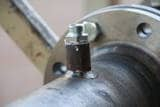KST – KROMSCHRÖDER SYSTEM TECHNOLOGY
5.2.1.7 Soundness

The gas pipework shall be tight and shall be designed to withstand the internal pressure.
The external leakage rate shall not give rise to a dangerous condition, flammable and/or toxic, in the foreseen circumstances of the equipment installation. The frequency of testing to determine the external leakage shall be specified in the instruction handbook.
NOTE It is generally agreed that an external leak rate of ~1dm3(n)/h will not give rise to a dangerous condition in typical ventilated industrial installations. The actual leak rate will depend upon the volume, number of connections, test gas, number of valves and component parts contained.
The external leak rate test method shall take into account the volume, number of connections, test gas, number of valves and component parts contained and temperature. Methods of testing shall include spray bubble leak identification and/or pressure decay test.1)
The following chapters are printed with the permission of the DIN Deutsches Institut für Normung e.V. (German Institute for Standardization). For the implementation of the DIN Standard, the version with the most recent issue date is deemed authoritative. This is available from Beuth Verlag GmbH, Burggrafenstrasse 6, 10787 Berlin, Germany.
![]()
Our note on this Standard:
1) The manufacturer is free to select the applicable regulations for design and execution of the gas distribution system. The literature references (informative section) are listed in the EN 13480 series of standards. The gas distribution system, formally as well, is covered by the scope of application of the Pressure Equipment Directive as of Category II. (See also Scope). Application of this series of standards or use of another set of harmonized regulations further to the Pressure Equipment Directive is advisable in this case.
An external tightness test of the distribution system must be conducted after installing and before commissioning. The test period must ensure that every leakage point which could result in escape of gas is reliably detected. The maximum operating pressure and the pressure resistance of the equipment used must be allowed for when stipulating the test pressure. The pressure for the tightness test may not be less than the operating pressure.
The interval for regular tests and inspections for external leakage is based on the information on maintenance of the equipment used, including the foreseeable/scheduled mode of operation of the IThE. The operator of the IThE requires this information in order to stipulate the intervals for the tests which he must conduct within the framework of national industrial safety regulations.
